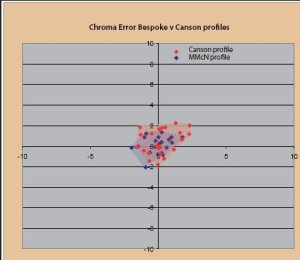articles/Paper/fourbaryt-page5
Paper Chase - The Four Baryt - part 5 of 1 2 3 4 5 6 7 8 9
by Mike McNamee Published 01/06/2010
The main errors lay in the lightness component which was, on a rough average, about twice the value for the errors in hue and saturation. In simple terms we can look at this error by comparing the mid-tone value with the aim value of 50%. The range was from 49% for Platinum Gloss rising to 50.6% for Canson Photographique (ie one was 1% dark, the other was 0.6% bright - trivial errors, in truth).
The Lab scatter plot for Canson is shown. Most of the short error bars are pointing inwards, ie a reduction of saturation and the relative size of the red error may be seen.

The Granger Charts for all four papers were good. There was a slight graininess in the light-medium yellow region and just perceptible banding in the green region of all samples. The Canson was slightly more open at the extreme highlight end of the Granger Chart perhaps a beneficial by-product of its very high base-reflectance. There was a little differential gloss in small parts of the Granger Charts mainly in the transition area between deep blue and full shadow. This effect was not visible in the Platinum Lustre. Gamut volumes were typical for baryta-like materials, way ahead of matt and canvas art media, but behind full gloss, lustre and proofing media.
Overall then, in terms of colour, these are fundamentally sound papers which behave in the predicted manner with no quirks or surprises, they can be recommended without hesitation on grounds of colour reproduction and general sharpness.
Please Note:
There is more than one page for this Article.
You are currently on page 5
- Paper Chase - The Four Baryt page 1
- Paper Chase - The Four Baryt page 2
- Paper Chase - The Four Baryt page 3
- Paper Chase - The Four Baryt page 4
- Paper Chase - The Four Baryt page 5
- Paper Chase - The Four Baryt page 6
- Paper Chase - The Four Baryt page 7
- Paper Chase - The Four Baryt page 8
- Paper Chase - The Four Baryt page 9
1st Published 01/06/2010
last update 09/12/2022 14:54:25
More Paper Articles
There are 56 days to get ready for The Society of Photographers Convention and Trade Show at The Novotel London West, Hammersmith ...
which starts on Wednesday 14th January 2026





